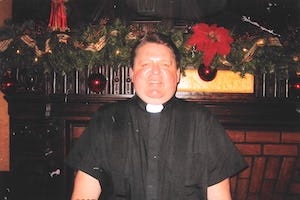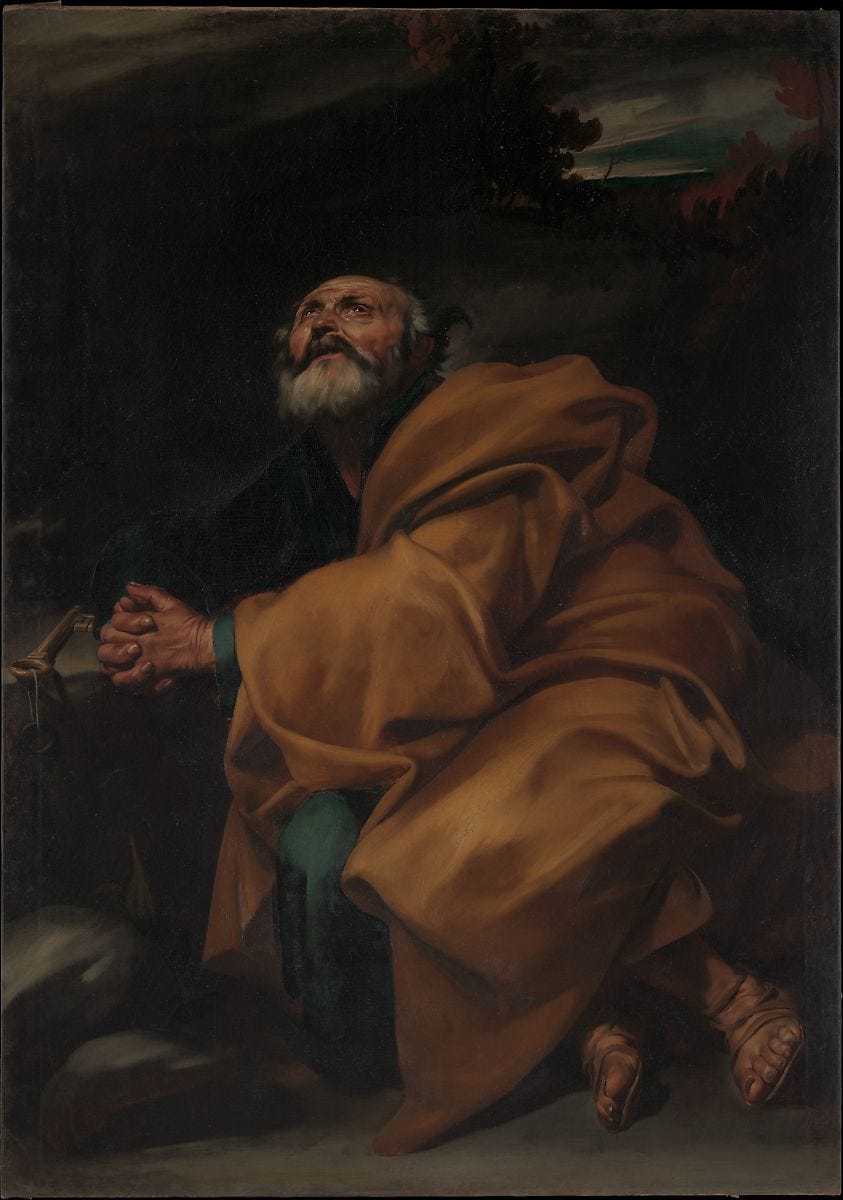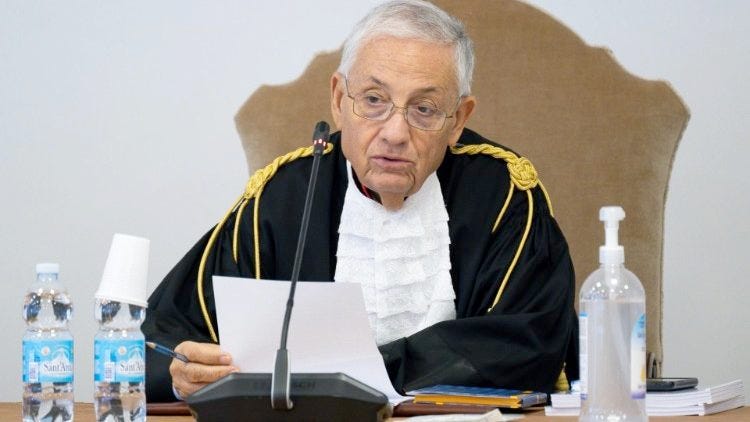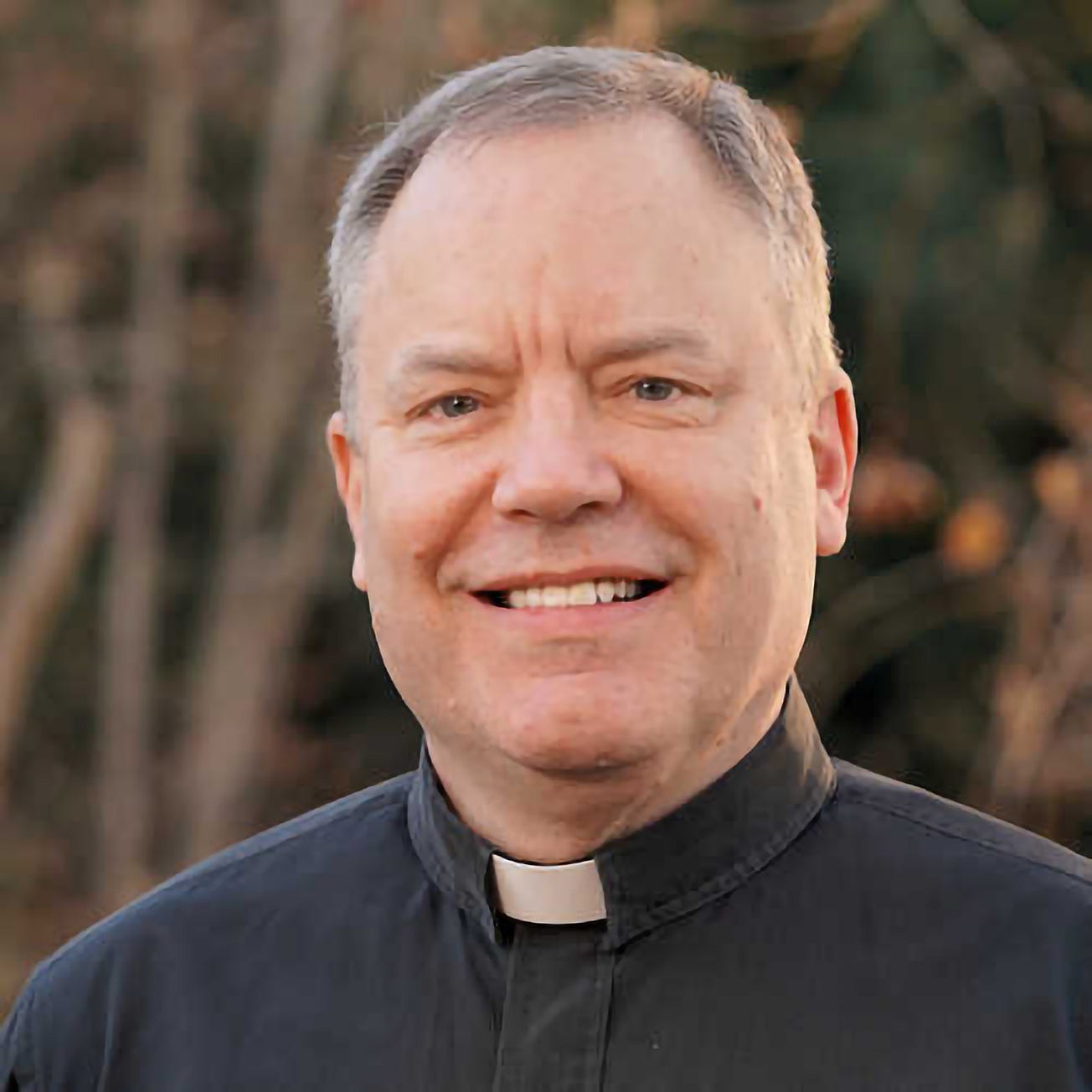Hey everybody,
Welcome to Holy Week, and to the Tuesday Pillar Post.
Tomorrow will be Spy Wednesday, and then with the Mass of the Lord’s Supper, we will enter the Sacred Triduum, the holiest days of our liturgical calendar.
Spy Wednesday, in which we remember the betrayal of Judas, is an invitation to reflect on our own betrayals of the Lord.
Judas, Pope Benedict XVI put it, “shamefully ceded to a temptation of the Evil One.”
He was, Pope Francis has said, “weak in his discipleship, but Jesus loved him…”
But why? Why did Judas betray Jesus? Because he loved money? Because he had grown to resent that the Lord was not the kind of political-militaristic messiah he’d been hoping for? Because he was weak?
In a homily decades ago, Benedict XVI had a particular theory I find most interesting: “Judas is neither a master of evil nor the figure of a demoniacal power of darkness but rather a sycophant who bows down before the anonymous power of changing moods and current fashion. But it is precisely this anonymous power that crucified Jesus, for it was anonymous voices that cried, ‘Away with him! Crucify him!’”
Is that why? Judas bowed to the zeitgeist? Perhaps.
But I think it is a providential feature of Judas’ betrayal that we can’t say with certainty what caused it. Because in the mystery of Judas’ betrayal, each one of us can find our own — why have I betrayed the Lord? What causes me to sell him out, to see him crucified?
And perhaps, more to the point, the mystery of Judas’ betrayal points to the mystery of sin itself.
Why do I sin? Why do I do what I want not to do?
I don’t always know.
There is a danger, for many of us, of turning repentance into the self-diagnosis preferred by our therapeutic culture, in which contrition is replaced by an endless carousel of subjective, uncertain, projecting self-assessments.
We are conditioned to prefer analysis to repentance. We are often convinced that with enough diagnosis, we can master our own wills, overcome our own vices, conquer our fallen natures.
But we can’t do those things. Only the Crucified One can.
Evil is not always explained. And explanations - for Judas and for myself - don’t always matter so much as we think.
Because what matters most is contrition. To look at the face of the Lord, to ask his forgiveness.
I imagine, by the way, that Judas must have avoided the gaze of the Redeemer, after he arranged to betray him.
I know the feeling of avoiding that gaze. It’s a feeling of indignity, embarrassment, tinged with a stubborn kind of hubris. And it ends with a headlong fall into Akeldama.
But Spy Wednesday is a reminder that we can’t get ourselves out of sin. We can’t work ourselves out of the messes we make. Instead, we have a savior, and that’s enough.
Why did Judas betray the Lord? I don’t know.
Why do I betray the Lord? I don’t know.
I only really know what to do about it — to enter the sacrament of mercy again, to admit that I have sinned, to resolve to sin no more, and to receive the grace of forgiveness, and the call to conversion.
That’s why he went to the Cross, isn’t it?
The true story of ‘Fr. Stu’
Fr. Stuart Long was a boxer-turned-actor-turned-convert-turned priest. He had a remarkable story, even before he was diagnosed with the serious medical condition that would weaken his body, cause him great suffering, and lead to his early death in 2014, at age 50, after seven years of an extraordinary priesthood.
“Fr. Stu,” released April 13 and produced by “Marky Mark” Wahlberg, aims to tell the story of Fr. Stuart Long’s incredible life. And it’s a pretty good movie. But it doesn’t come close to telling the whole story.
Lucky for us, The Pillar’s Michelle LaRosa spent more than a month on that project, talking to the people who knew and loved Stu the most. She talked with his dad, his sister, his best friend, the bishop who ordained him — and with the people who say he worked miracles in their lives.
For good measure, Michelle talked with Mark Wahlberg, too. But the story’s not really about him, and this is no movie review.
Here’s a preview:
Stu went to Lourdes in a wheelchair. But believed he would stand up and walk out of the shrine’s healing waters.
When he did stand up, though, he nearly fell over into the water. He couldn’t walk. He wasn’t healed.
Stu was devastated. He thought God had abandoned him.
But a friend on the trip encouraged him. Stu went back to the Lourdes water a second time, a few days later, after he he had gone to confession.
Whatever Stu said in that confession is unknown.
But “when he came out the second time, he had this sense of peace, just this real sense of peace, that wasn't there the first time,” Fr. Bart said.
“And he didn't experience the physical healing, but he had peace.”
Becciu.Catholic?
If you’ve been following the long, complicated story of Pillar reader Cardinal Angelo Becciu, now on trial for corruption and abuse of office, you probably have questions about the two million Australian dollars he authorized to be wired Down Under during the criminal trial of Cardinal George Pell.
Most people do.
Ed and I have done some checking on this. It’s true that the Holy See applied to ICANN, which regulates internet domains, to control the .Catholic top-level domain, and it’s even true that the Holy See appears to have a ten-year agreement in place to control it — with 12 websites in development which would use the domain. They seem also to have acquired the same TLD in Cyrillic, Chinese, and Arabic.
You can read our report about that transfer here.
The math, by the way, seems to check out. Applying for the .Catholic TLD and its corollaries, and paying related fees for a ten-year period, would add up to an amount of money pretty close to the $2 million transferred by the Vatican to the Australian offices of tech and security firm Neustar, Ltd.
So on its face, the story seems plausible.
But here’s what doesn’t add up: Becciu has said in the past that he transferred the money for “classified” and “highly confidential” purposes. Of course, he has a reflexive tendency to regard everything he does as secret, so it’s possible he maintains that something as banal as buying website domains — which can be found in publicly accessible records and databases, if you know where to look — as a highly confidential state secret.
It’s even possible, if the purpose of the purchase was to prevent trolls or foreign government propaganda from parking websites at .catholic domains, that he might really regard all this as a matter of state secrecy.
But there is one problem. In interviews, Msgr. Alberto Perlasca, once a top administrator in the Vatican Secretariat of State, apparently told Vatican prosecutors at one point that the money was for Pell’s legal defense. Pell has always maintained that’s not true. If it now seems demonstrably untrue, why did Perlasca lie, making a claim easily disproven, in the middle of the biggest set of financial scandals to hit the Vatican in a very long time?
We don’t know. And we don’t know what Perlasca was told. And while the math seems to check out, and we have a lot of indicating records, we don’t yet have receipts.
So this story isn’t quite finished yet. And the sticky questions it raises — they haven’t yet even begun to be answered.
Anyhow, read all about it in this report from The Pillar!
More news
Activist Lauren Handy is facing a federal indictment, the prospect of more than a decade in prison, and a media firestorm which began when Washington, D.C. police removed from her apartment the bodies of unborn babies she says may have been illegally aborted or, in one case, born alive and left to die.
But Handy has continued to protest, calling for DC authorities to autopsy those bodies for evidence of criminal activity, and her call — while facing heavy criticism — has also gained a broad spectrum of supporters.
The Pillar reported from a protest Friday, which led to some tense moments with police. But Handy told The Pillar that: “There is hope, and there is healing, and there is love, and there is beauty…We can create safe and sustainable communities for all of us. May God have mercy on us.”
—
The Easter Vigil is one of the most sacred and profoundly beautiful moments in the Church’s liturgical life — the annual pinnacle of the Christian calendar.
The Mass is filled with symbols you don’t see most Sundays — with a “blazing fire,” a priest carving a candle, a “service of light,” and an ancient proclamation of the Easter mystery.
If you’re going to the Easter Vigil, and you want to read up on what will happen — or if you can’t make it, and you want a taste of the experience — check out our Easter Vigil Mass explainer, right here.
If nothing else, you can read about the ancient, and mysterious, and possibly miraculous Orthodox Easter custom of the Holy Fire, in which a blue flame is said to rise up from the place where the body of Jesus Christ was lain.
Seriously, don’t miss that. Read here.
John Oliver is blackmailing Congress
Comedian John Oliver has an HBO television program called “Last Week Tonight,” in which he talks humorously about current events and the news, in a manner reminiscent of the show that made him famous, Comedy Central’s “The Daily Show.”
On his show Sunday night, Oliver did a segment on data brokers, who package and sell identifiable mobile app data, which can indicate internet app activity of particular mobile users.
This kind of technology might be familiar to you. The NY Times used it to identify persons who stormed the U.S. Capitol last January 6. Russian soldiers using hookup and sex apps in Ukraine have revealed troop movements to intelligence services. And last year, after The Pillar obtained online hookup app data, we reported about hookup app usage by a top-level official of the USCCB, in parish rectories, and in the Vatican City State — where, we reported, it leaves Vatican officials susceptible to blackmail and extortion.
Oliver mentioned us, in fact, while he raised objections to the availability of that kind of technology. And then, while lamenting the way in which that technology can jeopardize privacy, he threatened to release mobile app data about members of Congress, if they did not support the kind of data protection legislation he’s calling for.
To my surprise, Oliver has garnered widespread acclaim over this.
Whatever you think about the importance of data protection and privacy laws — and I’ve no objection to stronger ones, as it happens — it is surprising to see the broad celebration of a man using the threat of releasing embarrassing or compromising information, coercively, to achieve a policy goal he believes should be achieved.
The word for that is blackmail, to be clear.
Now, you might be surprised to hear The Pillar commenting on this. We’re controversial on the subject, as you might know. But it is an issue to which we have given a lot of thought.
After The Pillar reported about a USCCB official using hookup apps while traveling for his duties or at critical moments in the Church’s life — activity of a nature and frequency which seemed to us to be in conflict with a senior policy coordinating position — we were often asked why we didn’t tell USCCB officials that we would report the information only if the priest in question wasn’t fired.
That, we said, was blackmail, and would be wrong.
It would not be wrong to use publicly available information, legally obtained, to report legitimate news in the public interest — or even to serve as the basis for asking questions. That, we’ve argued, as have others, is the precedent set by the paper of record, the NY Times, when it comes to this kind of data.
But it would be wrong to use information to force or impose our will on Church officials. That’s not the place of journalism.
That idea has been our guiding principle, as we took pains in our reporting on technology usage to weigh which issues are really matters of public interest, and which are not, and to make clear that issue of public interest was precautionary, not prurient.
That is why we reported with specificity about a high-level Church official apparently engaged in potentially high-risk activity, but with more circumspection and discretion about rectories, where a “public interest” argument is much, much less credible.
The only difference that we see between us and the NY Times is subject matter: They reported on people with socially unacceptable political positions, while we reported on the more controversial topic of sexual activity among Catholic clerics in leadership positions.
But among those who disagreed with us about that, there does now seem to be support for John Oliver’s plan — blackmailing government officials. That is exactly, by the way, the threat facing the Vatican because of hookup app usage there — a point we made first in person at the Secretariat of State, and then in print.
So, in much of the public eye, is blackmail ok and news reporting not ok? I find that a bit confusing.
But the threat of blackmailing public officials because of their private activity — the exact risk we said the Vatican faces, is no longer a hypothetical reality. It’s a social media phenomenon, widely celebrated. We’d be foolish to think the Church mightn’t be a target — which is the point about which The Pillar has tried to raise alarms.
Ecclesiastical officials might be reticent to address technology accountability. And some Catholics are quick to jump on The Pillar’s efforts to sound the alarm. But if Church officials don’t handle the problems posed by new technology, rest assured, activists and TV hosts certainly will — and they likely won’t aim to make ethical distinctions about what is in the public interest, and what isn’t.
Our almsgiving reminder
As a final reminder: this Lent, for every new paying subscriber to The Pillar we’re giving $10 to the Archeparchy of Philadelphia’s Ukraine Relief Fund. And we’re giving $1 for every new free sign up to our mailing list.
So, now is the moment: If you like The Pillar, subscribe because it’s great journalism worth paying for — and because your subscription, or your gift subscription for a friend, will help us give more alms to the Ukrainian people.
Or share The Pillar with friends who might want to read The Pillar Post each week for free.
Today’s the day:
After Lent, we’ll stop bugging you about this for a little while. We promise. Really. We mean it.
‘The Tears of St. Peter’
In the Flynn household, this painting, “The Tears of St. Peter,” by Jusepe de Ribera, is at the center of our Holy Week meditations.
There’s a lot to see here. I post without comment, in the hope the Lord might speak to you through it, as he has done for us:
Blessed Holy Week.
Please be assured of our prayers, and please pray for us. We need it.
Sincerely yours in Christ,
JD Flynn
editor-in-chief
The Pillar







